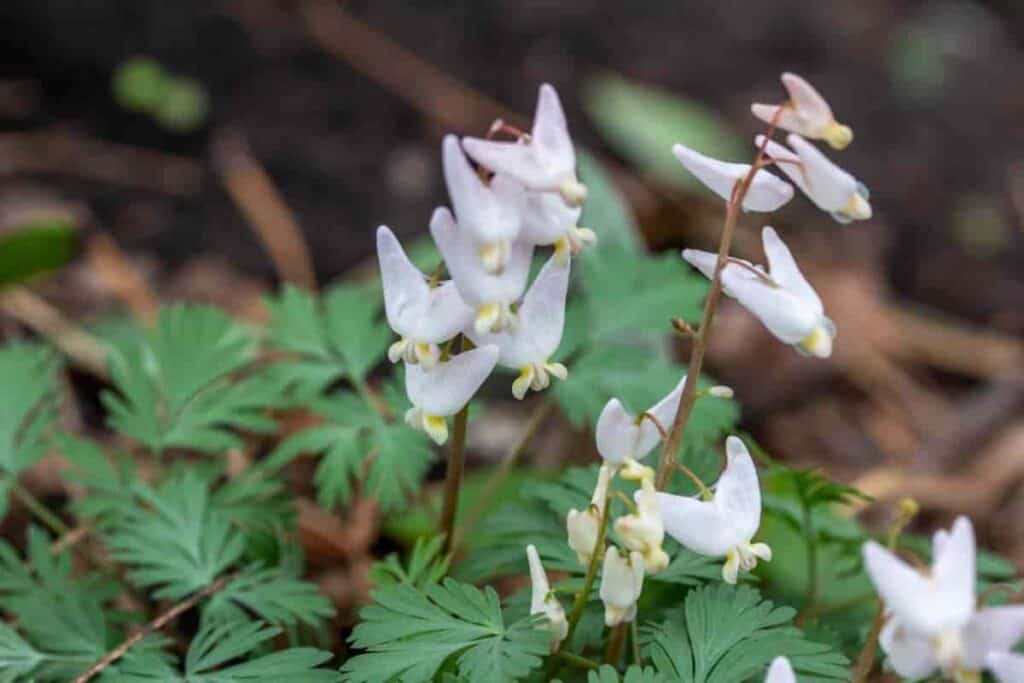During the first warm days of spring, two little woodland companions among our wildflowers, appearing at about the same time, are the dutchman’s breeches (Dicentra Cucullaria) and wild ginger (Asaruni canadense).
They are often found growing together, as Mother Nature planted them, on a wooded, rocky, secluded slope.

They are rated among the “top 12” for reliability and easy culture in the home garden.
Dutchman’s Breeches: Dicentra Cucullaria
Dutchman’s breeches are one of our most enchanting and daintiest wildlings.
It produces clusters of drooping, sweetly fragrant, creamy-white blossoms amid fountains of gray-green, finely-cut fernlike foliage.
Characteristics Of Dicentra Cucullaria
The flower stalk springs directly in front of the ground with 4 to 10 nodding flowers arranged along the stem.
The petals are joined to form curious little twin-spurred structures that resemble a Dutchman’s trousers, hanging upside down.
This little plant grows about 10” inches high and, despite its dainty appearance, is a hardy, long-lived perennial. However, its time above ground is brief.
After the blooming period is passed, these fascinating little blossoms seed themselves. The foliage quickly matures, dies clown, and leaves no trace of the plant during the summer.
Self-Seeding And Propagation
Besides self-seeding, Dicentra Cucullaria (Dye-SEN-tra Cook-yew-LAY-re-uh) can be propagated by dividing the clusters of small tubers that form the root stalk.
Plant each one separately to form a new plant. This can be done any time after the foliage dies down.
These plants grow best in soil rich in humus in a semi-shaded location.
Other Names And Species of Dutchman’s Beeches
Dutchman’s breeches have many other interesting names, showing that many people have loved this native.
“Soldier’s caps,” “whitehearts,” “eardrops,” and “butterfly banners” are some of them. There are other species of dicentra.
Dicentra Cucullaria is the best known and is growing over this country’s widest area.
Dicentra canadensis is another, but it is rare in the Midwest.
Wild Ginger: Asarum Canadense
While the wild ginger (Asarum canadense) (ASS-a-rum can-a-DENSE) may not attract as much attention as its companion, the dutchman’s breeches may not offer as much to offer in flower display. It is a very interesting plant and also a useful one.
It is interesting for the odd shape of its blossom, and the leaves are noted for their form and the exquisite satiny sheen of their upper surfaces.
Characteristics Of Wild Ginger
Two large, broadly heart-shaped, terminal leaves are borne on stout, hairy stems rising about 6 inches from the ground.
One blossom is inconspicuous as it is hidden at the junction of the two leafstalks near the ground.
It is brownish-purple in color and has a bell-shaped calyx with three pointed lobes that flare and turn back at the ends. It is about 1″ inch long.
The inside of this little cup-like flower resembles a pig’s snout, so it is sometimes called “pig-in-a-poke.”
Its Alternative Name
I like better the name often given to it by country children, “little brown jug.” Crawling insects fertilize the blossoms.
If necessary, the plant will lower them to the ground to simplify matters for the insects.
With its handsome green leaves, wild ginger makes a fine ground cover in a shady location and under shrubbery.
It can be seen used in this manner at Missouri Botanical Garden (Shaw’s Garden) in St. Louis.
Uses Of The Creeping Rootstock And Stems
The creeping rootstock and stems have a flavor of ginger when bruised.
We are told that when the first settlers reached our shores, they found Indians using the roots for flavor.
We also learn that Canadians used the dried pulverized roots as a spice and the early colonists used them as a substitute for ginger.
This rootstock was found to have medicinal properties and was used as a tonic and remedy for whooping cough.
Easy Propagation
Wild ginger is easily propagated by dividing the creeping root stalks. This can be done in either spring or fall.
Given the growing conditions it likes, good woodsy soil, and semi-shade, it will cover the ground surprisingly quickly.
44659 by Rebecca S. Gilliam
